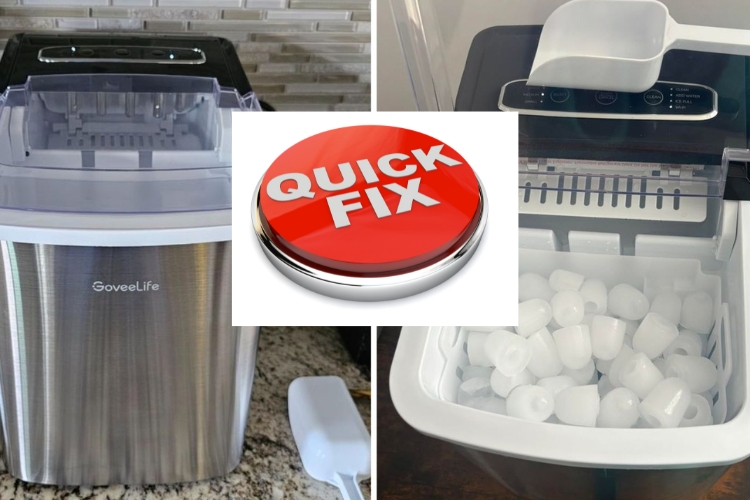
A portable ice maker is a compact appliance that creates ice by freezing water from its built-in reservoir. It relies on several interconnected components and systems to function properly. When any of these parts malfunction, the unit may stop producing ice altogether or produce low-quality ice. In this article, we’ll explore the most common reasons why your portable ice maker might not be working—and what you can do about it.
Common Issues with Portable Ice Makers
Issues within the mechanical systems of a portable ice maker can cause reduced performance or complete breakdown. If your portable ice maker has stopped working, here are some possible causes to consider.
1. Ice Maker Not Turning On
One of the most common problems users face is when the unit won’t power on. A portable ice maker may fail to turn on due to several potential reasons, including:
-
It’s Not Plugged in Properly
Ensure the plug is fully inserted into a working outlet to power your portable ice maker.
-
Incorrect Voltage
Some ice maker units require a specific voltage. Verify your outlet matches the unit’s requirements.
-
Tripped or Faulty Circuit Breaker
Check if the breaker connected to your outlet has tripped or is faulty, which can block power flow.
-
Damaged Power Cord
A frayed or faulty cord can interrupt power. Inspect the cable and replace it if it’s damaged.
2. No Water Entering the Ice Maker
For a portable ice maker to produce ice, water must be transferred from the reservoir to the cooling system. If this water flow is interrupted or blocked, the unit will not function properly.
So, if your ice maker isn’t producing ice, check whether water is reaching the cooling system. In most cases, water transfer fails due to a faulty water pump, which prevents the unit from moving water from the reservoir to the ice-making components.
3. Low Ice Production
Low ice production is another common issue with portable ice makers. This problem often points to a leak or blockage in the water or coolant systems.
-
Water Leaks
Leaks in the reservoir, hose pipe, or freeze tray prevent water from reaching the cooling system, resulting in no or slow ice formation.
-
Reservoir Leaks
When the water tank is leaking, insufficient water reaches the freeze tray, disrupting ice production.
-
Hose Blockages or Leaks
If the pump and reservoir are working, but no water reaches the freeze tray, the hose might be blocked or leaking.
-
Coolant Leaks
If no water issues are found but ice production is still low, look for oily liquid around the unit—it may indicate refrigerant loss.
4. Ice Not Ejecting Properly
Some portable ice makers may stop ejecting ice properly after extended use. This issue often results from ice buildup or residue in the ice tray. If your ice maker isn’t releasing ice, inspect the tray for grime or dirt. A dirty tray surface can cause ice to stick, leading to jams and ejection problems.
5. Ice Melting Too Quickly
Another common issue with portable ice makers is ice melting too quickly. This often happens when warm air enters the unit, raising the internal temperature and causing the ice to melt faster than expected.
The good news is that melted ice isn’t wasted—it’s recycled back into the water reservoir to make new ice. However, to avoid loss, it’s best to collect the ice promptly and store it in your freezer for later use.
Troubleshooting Steps for Portable Ice Makers
Now that you’re familiar with the common problems, here’s how to diagnose and fix issues in your portable ice maker:
1. Check the Power Supply
If your portable ice maker won’t power on, follow these steps:
-
Ensure Proper Plug Connection
Double-check that your ice maker is fully and securely plugged into a functioning outlet to ensure consistent power delivery.
-
Verify Correct Voltage Supply
Check that the outlet provides the required voltage for your specific ice maker model to operate properly.
-
Check the Circuit Breaker
Inspect your electrical panel to see if a breaker has tripped or is faulty, which could be cutting power to the outlet.
If everything appears normal but the unit still doesn’t turn on, contact a qualified electrician. They can inspect the power cord, outlet, and internal wiring for any damage that may require repair.
2. Ensure Proper Water Flow
A portable ice maker relies on proper water flow to produce ice. If it’s not making ice:
- Check for leaks in the water tank, hose, or coolant system. Leaks can prevent water from reaching the cooling tray.
- If you detect any leaks, it’s best to contact a qualified technician for professional repair.
- If there are no leaks but water still isn’t reaching the freeze tray, a clogged hose might be the problem.
To fix a clog:
- Fill the reservoir with water and a food-safe clog-removing solution.
- Run a cycle to flush the system.
- Discard any ice made during this process, as it may contain residues.
3. Clean the Ice Maker
Grime buildup in the hose or cooling system can reduce your portable ice maker’s efficiency. Regular cleaning helps restore performance. Follow these steps for a complete clean:
✅ Items You’ll Need:
- White vinegar or a commercial cleaning solution
- Soft cloth
- Toothbrush (for tight spots)
- Spray bottle with clean water
🧼 Cleaning Steps:
- Turn Off and Unplug: Disconnect the unit from the power supply before cleaning.
- Drain the Water: Open the drain plug (typically located on the back or bottom) and empty the reservoir.
- Prepare Cleaning Solution: Mix equal parts vinegar and water or use a commercial cleaner. Fill the reservoir.
- Run Cleaning Cycles: Plug in and run 2–3 ice-making cycles. Discard all ice produced during these cycles.
- Clean the Basket: While cycles are running, wipe the ice basket with a soft cloth.
- Scrub Internal Parts: Unplug and drain the unit. Use a toothbrush and cloth to clean inside thoroughly.
- Rinse: Refill the reservoir with filtered water and vinegar. Run another 2–3 cycles, then drain and dry the parts.
- Final Cycle: Run one last cycle with clean water only and discard the ice to ensure no residue or odor remains.
Cleaning your ice maker regularly keeps it running smoothly and extends its lifespan.
4. Adjust the Ice Making Cycle
If your portable ice maker is too slow, try adjusting the ice-making cycle by lowering the freezing temperature. A lower temperature helps the water freeze faster as it flows over the coolant. This speeds up the ice production process and also triggers the metal coolant bars to heat up more quickly, releasing the ice into the storage bucket more efficiently.
5. Reset the Ice Maker
Like many appliances, a simple reset can often solve unexpected issues with a portable ice maker. Unplug the unit and let it rest for about 10 seconds to reset the internal system. Then, plug it back in and press the power button to restart.
Some models include a dedicated reset button. If yours does, locate it and follow the reset procedure outlined in the user manual for proper steps.
6. Inspect and Replace Faulty Parts
A portable ice maker depends on all its components working together. If it’s still not functioning after basic troubleshooting, some internal parts may be faulty. Inspect key components—such as the compressor, thermostat, fan, or control board—for signs of damage.
However, if you’re not experienced with electrical appliances, it’s best to take the unit to a qualified technician. They can safely diagnose and replace any faulty parts to restore proper operation.
Additional Tips for Maintaining Portable Ice Makers
To ensure your portable ice maker runs efficiently and lasts longer, follow these simple maintenance tips:
1. Regularly Clean and Descale
Clean your portable ice maker every 1–2 months based on usage. This prevents grime, reduces clogging, and ensures hygienic ice production.
2. Use Filtered Water
Using filtered water improves ice taste and prevents mineral buildup, which can damage internal parts and make cleaning more difficult.
3. Keep in a Cool, Dry Place
High temperatures affect performance. Place your ice maker in a cool, dry area to avoid overheating and ensure faster ice production.
4. Remove Ice Regularly
Don’t let ice sit too long. Regularly remove ice from the bin to prevent melting and grime buildup that can affect performance.
5. Seek Professional Help When Needed
Leave electrical repairs to certified technicians. DIY electrical fixes can lead to serious damage or safety risks.
6. Follow Safety Precautions
Always follow the manufacturer’s safety guidelines in the manual. This keeps both you and the machine safe during operation.
7. Watch for Warning Signs
Pay attention to warning indicators on the unit. These often point to serious internal issues. Refer to your user manual for details, and keep it in a safe place for future reference.
8. Importance of Professional Repairs
Technicians can diagnose deeper issues and advise whether to repair or replace the unit. Sometimes, upgrading to a new model is more cost-effective than repeated repairs.

James Hartley
Appliance Repair Specialist & Contributor
James has over 10 years of experience repairing home appliances, with a special focus on portable ice makers and refrigeration units. He shares DIY repair tips, maintenance advice, and troubleshooting guides to help homeowners get the most out of their machines.